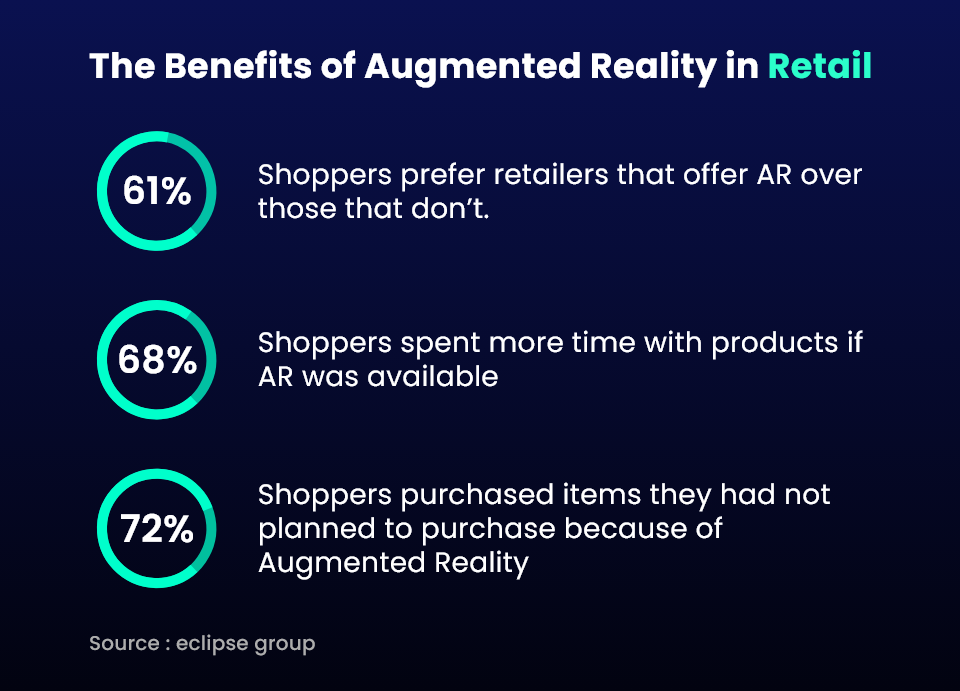The retail sector is rapidly transforming by adopting state-of-the art technologies like artificial intelligence (AI), cloud, data analytics, virtual reality (VR), and augmented reality (AR). AR integration in retail is building an immersive experience for shoppers and expanding the scope of retail visual merchandising.
What is AR?
Augmented reality creates an extended version of real surroundings by superimposing computer generated images over an existing environment. Implementation of AR happens through AR headsets and mobile phones. This makes it very easy to integrate into the retail space to create an extended view of the space.
AR Market Trend in Retail
AR integration in the retail space is a part of the digital transformation initiative today’s retail businesses are adopting to engage. AR is being adopted for both online and offline experience.
Some interesting facts about AR adoption in retail are.
- The global market for AR in retail is expected to reach $79.51 billion by 2023.
- 61% of shoppers prefer retailers that offer AR over those that don’t.
- AR is being used by retailers in a variety of ways, including product visualization, virtual try-on, instructions, and branding.
- AR can help retailers to improve the customer experience, increase sales, and build brand awareness.
Interesting Use Cases of AR Integration in Retail
IKEA
IKEA uses AR catalog to project furnitures as how they would look in reality. After selecting an item from the catalog it can be projected in a virtual environment of the room. This helps users to make decisions about the look and positioning of the furniture in a very short time.
Starbucks
As a brand engagement strategy Starbucks takes through a unique virtual tour of the coffee bean preparation process. A Starbucks store in Shanghai allows visitors to point the phone towards the traditional roasting cask and other artifacts and a virtual tour of processing coffee beans to making a cup of coffee ensues.
Nike
Nike has an AR powered shopping app that allows customers to choose the right sized shoes. The customers can scan their feet to experience how the shoe would look in reality. This converts more visitors in the Nike app to buyers. If any measurements are still required to be taken manually Nike can advise customers to visit the nearest store. Virtual try-ons offered by Nike provide a reduced number of return orders significantly.
Toyota
Toyota offers an AR application for an immersive car accessories shopping experience. The app employs technologies like Machine Learning and Apple’s ARKit. Customers can add computer generated accessories images on their car to see how it looks and feels.
Benefits of AR in Retail Visual Merchandising

Virtual Tours
Online customers can get the feel of visiting a store with the help of AR. This leaves a scope to explore all the retail visual merchandising strategies of in store shopping avoiding the drawbacks of overcrowding or consuming real space.
Gamification
Gamification is a brand engagement strategy and an interesting way to attract new buyers. Gamification increases customer touchpoints and helps to collect data to understand customers’ thought process. AR is an excellent tool to introduce gamification in eCommerce through mobile apps.
Product Visualization
AR enables buyers to understand products better as they can try them from various angles and in different colors and sizes. Virtual try on allows users to use virtual trial rooms to see how some apparels and shoes would fit. Product visualization also involves placement preview of a furniture to check how it fits with the surroundings.
Conclusion
The incorporation of augmented reality (AR) technology in different facets of retail, including digital displays, try-on features, and navigation, is poised to revolutionize conventional physical stores. It is merely a question of when these immersive shopping experiences will become the standard. The future of in-store shopping holds the potential to resemble scenes from science fiction movies, offering customers the opportunity to make better-informed buying choices and enjoy an overall improved shopping experience.
